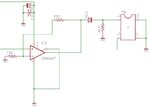ants
Full Member level 4
The bobbin, core and coils came today. I bought half cores which fit into the bobbin but I should have bought full core, it isn't a problem for test pieces though, I just want to learn what to do. The wire I bought is 0.2, 0.3, 0.4, 0.5 and 0.8mm squared. The 0.8mm is hard to wire, so I think it'd be best to use the 0.5 and below. I have a few questions, is it better to wire the coils next to each other or on top of each other? Should I glue the core top down or bottom up?
Choosing the values of inductance for each coil is difficult. I've attached the circuit I'm using. Essentially the output from an opamp is AC coupled and this fed into the transformer to be made, the load is a piezo.
The task is to wire the transformer to give maximum power transfer. The AC coupling capacitor is 10uF and low ESR. The piezo is 1nF and operates at its resonante frequency of 40KHZ, its impedance is unknown. The wiring ratio isn't critical but I'm targetting 1:5. I have tested an existing transformer with different added capacitance to the piezo load and in some circumstances it does help power transfer as mentioned earlier in the thread. The opamp (OPA 548 ) also mentions that an RC network on the load also helps with stability for capacitive loads. It suggests 10nF-100nF and 3-10 ohms.
I've done some numbers. The capacitive load should be the piezo plus 10nF for stability = 11nF
With a wiring ratio of 1:5 the capacitance reflected back to the primary coil will be 11nF x 25 = 275nF
At resonance of 40KHz the tank inductance of 275nF is about 60uH.
This implies the secondary coil is around 1500uH
Do the numbers look ok? Any suggestions welcome.
Thanks,
Ant.
Choosing the values of inductance for each coil is difficult. I've attached the circuit I'm using. Essentially the output from an opamp is AC coupled and this fed into the transformer to be made, the load is a piezo.
The task is to wire the transformer to give maximum power transfer. The AC coupling capacitor is 10uF and low ESR. The piezo is 1nF and operates at its resonante frequency of 40KHZ, its impedance is unknown. The wiring ratio isn't critical but I'm targetting 1:5. I have tested an existing transformer with different added capacitance to the piezo load and in some circumstances it does help power transfer as mentioned earlier in the thread. The opamp (OPA 548 ) also mentions that an RC network on the load also helps with stability for capacitive loads. It suggests 10nF-100nF and 3-10 ohms.
I've done some numbers. The capacitive load should be the piezo plus 10nF for stability = 11nF
With a wiring ratio of 1:5 the capacitance reflected back to the primary coil will be 11nF x 25 = 275nF
At resonance of 40KHz the tank inductance of 275nF is about 60uH.
This implies the secondary coil is around 1500uH
Do the numbers look ok? Any suggestions welcome.
Thanks,
Ant.
